Short answer: Grating ginger is usually better for tea as it exposes more surface area, releasing more flavor and nutrients. However, slicing is easier and still provides a decent flavor.
Ginger tea is a popular beverage known for its warm, spicy flavor and health benefits, such as aiding digestion and soothing a sore throat. The method you choose to prepare the ginger – whether grating or slicing – can significantly impact the intensity of the flavor in your tea. Grating ginger typically releases more flavors and nutrients, but slicing ginger is easier and can still produce a delightful tea. The choice ultimately depends on personal preference and the strength of the flavor desired.
Why Is Ginger Used In Tea?
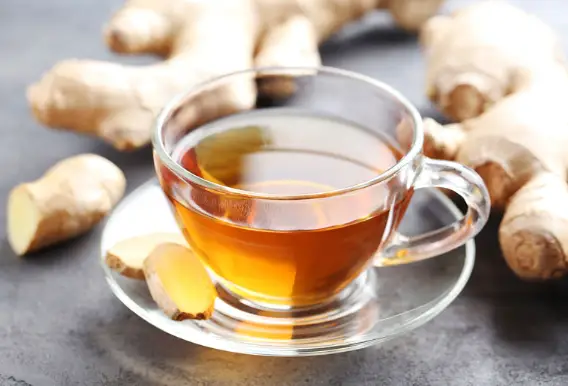
Ginger is used in tea for several reasons:
- Its distinctive warm and spicy flavor can enhance the taste of the tea, providing a unique sensory experience. But beyond this, ginger also boasts several health benefits that have made it a popular choice for infusion in tea.
- It’s known for its anti-inflammatory and antioxidant properties, and it has traditionally been used in herbal medicine to aid digestion, alleviate nausea, and even fight off cold and flu symptoms.
- Its soothing properties make it a good choice for those suffering from a sore throat or upset stomach.
- The aroma of ginger can also have a calming effect, making it a popular choice for those seeking relaxation.
- Ginger tea is caffeine-free, so it can be enjoyed at any time of the day without affecting sleep.
Is It Better To Grate Or Slice Ginger For Tea?
When preparing ginger for tea, the method you choose can significantly impact the flavor and potency of the beverage. Both grating and slicing are common methods, and each has its benefits and considerations.
Grating ginger tends to yield a more potent flavor and aroma, as it exposes more of the ginger’s surface area to the water, allowing for a greater release of its natural oils and beneficial compounds. Consequently, if you prefer a strong, intense ginger flavor in your tea, grating might be the best option.
On the other hand, slicing ginger is simpler and less time-consuming. While it may not release as much flavor as grating, it can still provide a noticeable ginger taste. Sliced ginger is also easier to remove from the tea before drinking, which can be a practical consideration for some.
Slicing Ginger
Step 1: Start by trimming the ginger root to prepare it for slicing.
Step 2: Slowly slice the ginger without forcing the knife into the edges.
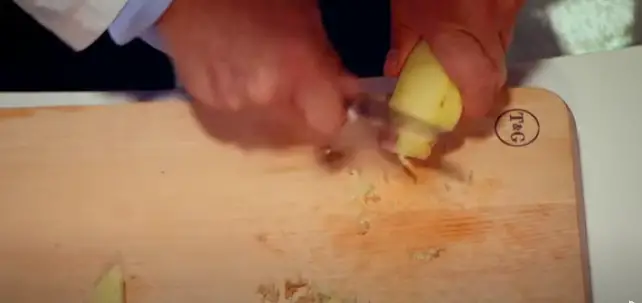
Step 3: After trimming, use the back of your knife to peel or scrape off the skin. This method is finer than using a standard peeler and removes the dry, flavorless part of the ginger skin.
Step 4: Once the ginger is peeled, clean off your cutting board.
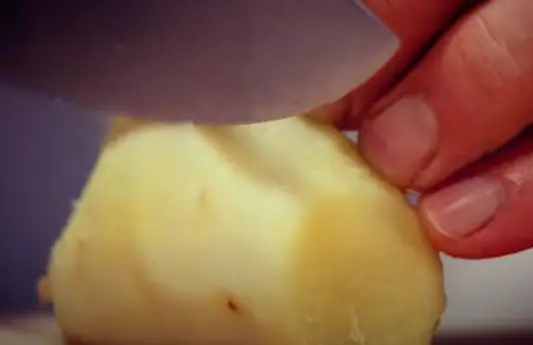
Step 5: Carefully slice the ginger again. Make sure the ginger piece is stable on the board for safety.
Step 6: Now, keep all the sliced pieces together and cut them into long, thin strips, known as julienne strips. Use your index finger to control the size of the juliennes. The index finger should be placed on the top of the blade to guide the knife.
Step 7: Once you have your juliennes, turn them over.
Step 8: Cut the juliennes into little squares. This technique is known as “Brunoise”. Again, use your index finger to guide the knife and determine the size of the squares.
Step 9: Collect the finely cut ginger pieces.
Grating Ginger
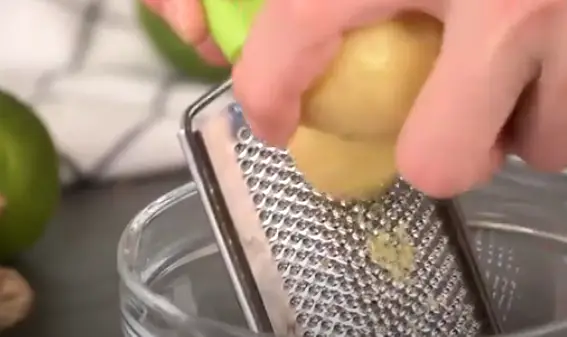
Step 1: Start by selecting a fresh ginger root that has smooth, unwrinkled skin. This indicates that the ginger is not past its prime.
Step 2:Square up the ginger by cutting off the edges with a knife.
Step 3:Peel the ginger. Make sure you have a piece of ginger that’s big enough to hold comfortably in your hands when you’re grating, to avoid accidentally scraping your fingers.
Step 4:Once the ginger is peeled, grate it using a cheese grater. Use the smallest holes on the grater. Alternatively, a rasp can also be used.
Step 5:Grate down one area of the ginger. The shredding process will leave the fibrous material on the outside of the grater, and the inner flesh, which is used for cooking, on the inside.
Step 6:To store the grated ginger, place it in a small jar with some water and refrigerate it. This can be stored for up to a week. Alternatively, you can use dry sherry wine instead of water for a different flavor.
Step 7:If you only need a small amount of ginger, you can wrap the remaining ginger and store it in the refrigerator for about three weeks, or freeze it for up to six months.
This method of grating ginger is simple and effective for getting the most flavor out of the root while minimizing waste.
Slicing Ginger Vs Grating
Taste: Grating ginger tends to yield a more potent, intense flavor. This is because grating the ginger exposes more surface area, allowing for a greater release of ginger’s natural oils and beneficial compounds. On the other hand, slicing ginger offers a milder flavor, which might be preferred by those who enjoy a subtler hint of ginger in their tea.
Time: Slicing ginger takes less time and effort compared to grating. Slicing only requires a few cuts, while grating involves more manual work. However, if the intense flavor resulting from the grating is desired, the additional time spent may be considered worthwhile.
Color: Generally, the method of preparing ginger might not significantly impact the color of the tea. However, given that grated ginger releases more of its constituents into the water, the resulting brew could potentially be slightly darker compared to a brew made with sliced ginger. The difference, if any, is likely to be subtle.
Nutrient Extraction: Grating ginger may also result in higher extraction of ginger’s healthful compounds, like gingerol, due to the increased surface area.
Straining: Sliced ginger is easier to strain out of the tea compared to grated ginger. If you prefer not to have small ginger pieces in your tea, slicing might be a better option.
Reusability: Slices of ginger can sometimes be reused for multiple infusions, although the flavor will be weaker with each subsequent use. Grated ginger, on the other hand, usually infuses most of its flavor in the first use.
How To Make Ginger Tea?
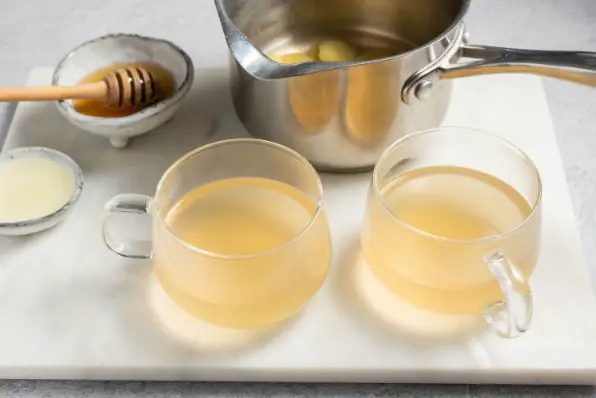
Step 1: Start by selecting a fresh ginger root. It should be plump, with an even color, and no major wrinkling or cracking on the skin.
Step 2: Wash the ginger root to remove any leftover dirt or grime.
Step 3: Using a knife, peel off the skin of the ginger. This leaves behind the flavorful interior of the root.
Step 4: Slice the peeled ginger root into small chunks to maximize the surface area for optimal steeping.
Step 5: Once the ginger pieces are prepared, place them into a teapot without an infuser or containment device.
Step 6: Pour hot water over the ginger chunks.
Step 7: Allow the ginger to steep for a significant amount of time. Ginger doesn’t get bitter with extended steeping like some teas, so feel free to let it steep for a while. Note that the intensity of the ginger’s “kick” will increase with longer steeping times.
Step 8: The tea is ready once it reaches a pale tan color. Despite the light color, the flavor will be noticeable and can be adjusted according to steeping time.
Step 9: Enjoy the tea as is or with any preferred additives. It can be consumed hot, or used as a base for a cold brew.
How To Make Ginger Tea With Lemon?
Step 1: Pour 8 ounces of hot water into a small bowl with half or one teaspoon of fresh or dried ginger.
Step 2:Let it sit for 10 minutes and then strain the liquid into a cup.
Step 3:Add a slice of lemon or the juice of half a lemon.
Step 4: Drink and enjoy! For added health benefits and a touch of sweetness, you can add one teaspoon of good-quality honey. You can also add 1-2 ice cubes for a refreshing drink on hot summer days.
Health Benefits Of Ginger
Relieves nausea: Ginger is effective in helping to relieve nausea and vomiting. It stimulates the production of saliva and gastric juices, aiding digestion.
Improves digestion and acts as an anti-inflammatory: Ginger can speed up the stomach-emptying process, reducing the occurrence of indigestion. It can also relieve inflammation in the stomach.
Strengthens the immune system: Ginger enhances blood circulation and strengthens the immune system, helping the body to fight off infections.
Balances blood sugar levels: Ginger has been found to improve blood sugar levels in people with diabetes.
Lowers cholesterol levels: Ginger has been shown to reduce markers of heart disease and the activity of bad LDL cholesterol and triglycerides.
Aids weight and fat loss: Ginger can help promote feelings of fullness and can prevent overeating when combined with a healthy diet and exercise.
Reduces period pain: Ginger can significantly reduce menstrual pains, especially when consumed in the form of ginger tea.
Reduces muscle pain: Consuming ginger in small amounts daily can reduce muscle pain and accelerate recovery after an intense workout.
Prevents cancer: The compound 6-shogaol in ginger has been shown to target the root cause of cancer cells, especially in breast cancer.
Reduces arthritis pain and improves mobility: Daily consumption of ginger has been shown to significantly reduce osteoarthritis pain and improve mobility in patients.
Improves brain function and protects against dementia and Alzheimer’s disease: Compounds found in ginger can help prevent degenerative diseases such as dementia, Alzheimer’s, Parkinson’s disease, and multiple sclerosis.
FAQs
How do I keep my tea warm?
There are a few methods to keep your tea warm:
- Use a Tea Cozy: This is a thick insulating cover for a teapot. It traps the heat inside, keeping the tea warm for longer.
- Use a Thermal Mug: If you’re drinking tea alone, pour it into a thermal mug or flask immediately after brewing. This can keep the tea warm for several hours.
- Use a Teapot Warmer: This is a small stand that holds a lit tea light candle to gently warm the pot.
- Pre-warm your teapot or cup: Pouring boiling water into your teapot or cup to warm it up before you make your tea can help keep your tea warm for longer.
Can you freeze ginger?
Yes, you can freeze ginger. It is a great way to preserve it. You can peel and grate it, then freeze it in ice cube trays, or freeze it whole and grate as needed.
How much ginger do you need?
The amount of ginger you need depends on the recipe. For ginger tea, half or one teaspoon of fresh or dried ginger per 8 ounces of water is recommended. Keep in mind that ginger is quite strong, so you might want to start with less and add more to taste.
Can I use dried ginger root?
Yes, you can use dried ginger root to make ginger tea. The flavor might be slightly different, and you might need to use more or less depending on your taste preference.
Can I make ginger tea with a tea bag?
Yes, you can make ginger tea with a tea bag. Just follow the instructions on the package. Usually, you would steep the tea bag in hot water for about 5 minutes. Keep in mind that the flavor might be milder compared to using fresh ginger.
How do I reheat ginger tea?
To reheat ginger tea, you can put it in a pot and heat it over low heat until it’s warm. Alternatively, you can use a microwave. Pour it into a microwave-safe container and heat it in 30-second intervals, stirring in between until it’s warm. Be careful not to overheat as it can cause the tea to lose its flavor.
Can I cut ginger into bits and swallow it?
Yes, you can cut ginger into small pieces and swallow them. However, be aware that ginger has a very strong flavor that can be spicy and might cause discomfort if swallowed in large chunks. It’s generally easier to consume if it’s grated or finely chopped and used in recipes like tea or food.
Conclusion
Both grating and slicing have their advantages when it comes to making ginger tea. If you prefer a more robust ginger flavor, grating might be the better choice. If you prefer a subtler flavor or like the convenience of easy removal, go for slicing. It’s all about finding what works best for your taste buds and convenience.

John Hebdon is a food enthusiast, passionate chef, and author of various articles and blog posts related to food and cooking. With a deep love for all things culinary, John’s blog serves as a platform to share his extensive kitchen experiences with a broader audience.
In addition to his culinary expertise, John has a flair for writing and a natural ability to share his passion for food with others. His articles and blog posts are informative, engaging, and packed with practical tips for readers of all skill levels.
As a food enthusiast and writer, John is always on the lookout for new and exciting culinary experiences. Whether it’s trying out a new restaurant, experimenting with a new recipe, or simply sharing a favorite dish with friends and family, John is always eager to explore and share the world of food with others.






